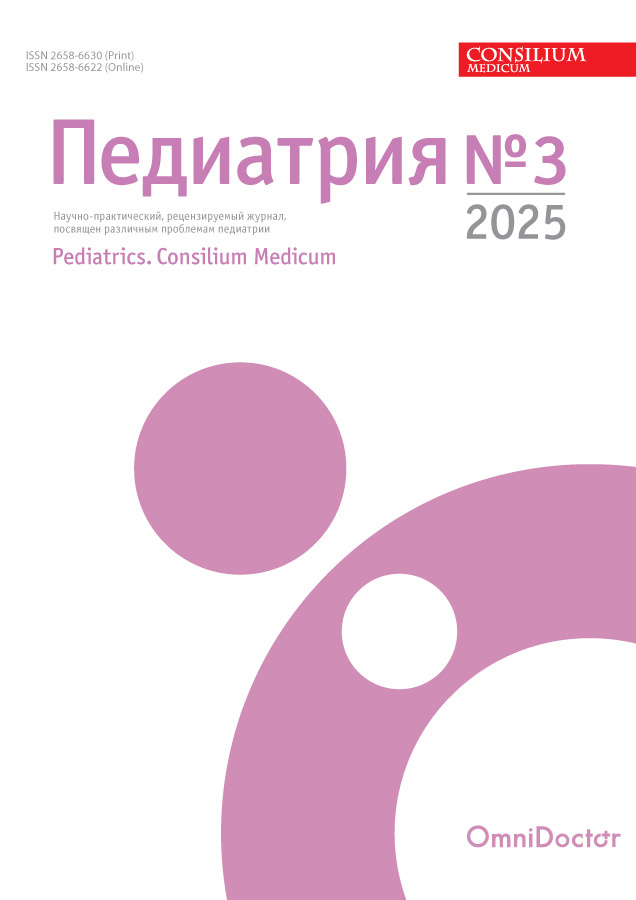The importance of collecting a family history of severe cardiovascular diseases in children with familial hypercholesterolemia and dyslipidemia of other origins: A retrospective study
- Authors: Pupykina V.V.1, Zakharova I.N.1
-
Affiliations:
- Russian Medical Academy of Continuous Professional Education
- Issue: No 3 (2025)
- Pages: 264-267
- Section: Articles
- URL: https://pediatria.orscience.ru/2658-6630/article/view/689511
- DOI: https://doi.org/10.26442/26586630.2025.3.203414
- ID: 689511
Cite item
Full Text
Abstract
Background. Currently, cardiovascular diseases (CVD) retain their leading positions in the structure of morbidity and are not only the leading cause of mortality, but also the main factor in population disability. The main pathogenetic link in CVD of atherosclerotic genesis is atherogenic dyslipidemia. Familial hypercholesterolemia (FH) plays a special role. Identification of family history is a prerequisite for timely diagnosis and prevention of CVD.
Aim. To conduct a comparative analysis and quantitative assessment of the frequency of cardiovascular events among relatives of children suffering from FH, as well as dyslipidemia of other genesis (DOG).
Materials and methods. The study was conducted at the Bashlyaeva City Clinical Hospital of the Moscow Health Department from January 2022 to August 2024. The study included 1,163 children diagnosed with hypercholesterolemia of various origins. Of these, 446 children with FH and 717 children with DOG.
Results. When assessing the family history of 446 patients with FH, 161 children (36.1%) were identified whose relatives died as a result of acute cardiovascular events (ACVE) [n = 211]. 143 relatives of 127 patients (28.48%) with FH suffered ACVE but remained alive. As a result of the analysis of the family history, it was revealed that 71 relatives of 79 children (17.71%) with FH underwent surgery. The family history of relatives of patients (n = 717) with DOG showed that 160 relatives of 136 patients (18.97%) also died as a result of ACVE. 231 relatives of 193 patients (26.92%) with DOG suffered ACVE but remained alive. Surgical intervention was in the anamnesis of 30 relatives of 22 patients (3.07%) with DOG.
Conclusion. The study showed that 64.57% of patients with FH had relatives who suffered or died from ACVE, while in the group of individuals with DOG this figure was 45.89%. The frequency of ACVE among relatives of patients with FH was 18.68% higher than in the group of patients with DOG. These data indicate a higher expression of familial risk within FH compared to other forms of dyslipidemia. Thus, systematic analysis of family history in all children with hypercholesterolemia, regardless of its genesis, contributes to early identification of high-risk groups and allows timely implementation of preventive measures and prescription of targeted treatment.
Full Text
About the authors
Victoria V. Pupykina
Russian Medical Academy of Continuous Professional Education
Author for correspondence.
Email: vika-pupykina@mail.ru
ORCID iD: 0000-0003-2181-8138
Аssistant
Russian Federation, MoscowIrina N. Zakharova
Russian Medical Academy of Continuous Professional Education
Email: vika-pupykina@mail.ru
ORCID iD: 0000-0003-4200-4598
D. Sci. (Med.), Prof.
Russian Federation, MoscowReferences
- Fakhrzadeh H, Tabatabaei-Malazy O. Dyslipidemia and cardiovascular disease. Dyslipidemia: from prevention to treatment. 1st ed. Croatia: InTech, 2012; p. 303-20. Available at: http://ndl.ethernet.edu.et/bitstream/123456789/50151/1/Roya%20Kelishadi.pdf#page=315. Accessed: 24.08.2025.
- World Health Organization. The Top 10 Causes of Death. Available at: https://www.who.int/news-room/fact-sheets/detail/the-top-10-causes-of-death. Accessed: 24.08.2025.
- Roth GA, Mensah GA, Johnson CO, et al. GBD-NHLBI-JACC Global Burden of Cardiovascular Diseases Writing Group. Global Burden of Cardiovascular Diseases and Risk Factors, 1990-2019: Update From the GBD 2019 Study. J Am Coll Cardiol. 2020;76(25):2982-3021. doi: 10.1016/j.jacc.2020.11.010
- Chong B, Jayabaskaran J, Jauhari SM, et al. Global burden of cardiovascular diseases: projections from 2025 to 2050. Eur J Prev Cardiol. 2025;32(11):1001-15. doi: 10.1093/eurjpc/zwae281
- Brunham LR, Lonn E, Mehta SR. Dyslipidemia and the Current State of Cardiovascular Disease: Epidemiology, Risk Factors, and Effect of Lipid Lowering. Can J Cardiol. 2024;40(8S):S4-12. doi: 10.1016/j.cjca.2024.04.017
- Pirillo A, Casula M, Olmastroni E, et al. Global epidemiology of dyslipidaemias. Nat Rev Cardiol. 2021;18(10):689-700. doi: 10.1038/s41569-021-00541-4
- Balling M, Nordestgaard BG, Langsted A, et al. Small Dense Low-Density Lipoprotein Cholesterol Predicts Atherosclerotic Cardiovascular Disease in the Copenhagen General Population Study. J Am Coll Cardiol. 2020;75(22):2873-5. doi: 10.1016/j.jacc.2020.03.072
- Ference BA, Ginsberg HN, Graham I, et al. Low-density lipoproteins cause atherosclerotic cardiovascular disease. 1. Evidence from genetic, epidemiologic, and clinical studies. A consensus statement from the European Atherosclerosis Society Consensus Panel. Eur Heart J. 2017;38(32):2459-72. doi: 10.1093/eurheartj/ehx144
- Domanski M, Tian X, Wu C, et al. Time Course of LDL Cholesterol Exposure and Cardiovascular Disease Event Risk. JACC. 2020;76(13):1507-16. doi: 10.1016/j.jacc.2020.07.059
- Hu P, Dharmayat KI, Stevens CAT, et al. Prevalence of Familial Hypercholesterolemia Among the General Population and Patients With Atherosclerotic Cardiovascular Disease: A Systematic Review and Meta-Analysis. Circulation. 2020;141(22): 1742-59. doi: 10.1161/CIRCULATIONAHA.119.044795
- Ference BA, Yoo W, Alesh I, et al. Effect of long-term exposure to lower low-density lipoprotein cholesterol beginning early in life on the risk of coronary heart disease: a Mendelian randomization analysis. J Am Coll Cardiol. 2012;60(25):2631-9. doi: 10.1016/j.jacc.2012.09.017
- Пшеничникова И.И., Пупыкина В.В., Ежов М.В., Захарова И.Н. Детско-родительский каскадный скрининг – эффективный инструмент раннего выявления пациентов с семейной гиперхолестеринемией. Медицинский Совет. 2025;(1):150-4 [Pshenichnikova II, Pupykina VV, Ezhov MV, Zakharova IN. Parent-child cascade screening – an effective tool for early identification of patients with familial hypercholesterolemia. Meditsinskiy Sovet. 2025;(1):150-4 (in Russian)]. doi: 10.21518/ms2025-005
- Dwyer T, Sun C, Magnussen CG, et al. Cohort Profile: the international childhood cardiovascular cohort (i3C) consortium. Int J Epidemiol. 2013;42(1):86-96. doi: 10.1093/ije/dys004
- Nordestgaard BG, Chapman MJ, Humphries SE, et al.; European Atherosclerosis Society Consensus Panel. Familial hypercholesterolaemia is underdiagnosed and undertreated in the general population: guidance for clinicians to prevent coronary heart disease: consensus statement of the European Atherosclerosis Society. Eur Heart J. 2013;34(45):3478-90a. doi: 10.1093/eurheartj/eht273
- De Ferranti SD, Steinberger J, Ameduri R, et al. Cardiovascular risk reduction in high-risk pediatric patients: a scientific statement from the American Heart Association. Circulation. 2019;139(13):e603-34. doi: 10.1161/CIR.0000000000000618
Supplementary files








